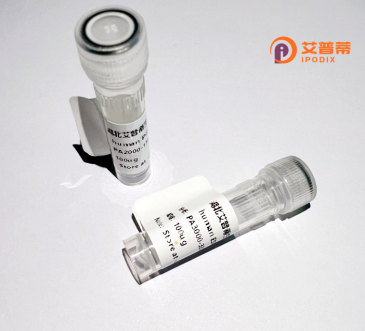
| 纯度 | >90%SDS-PAGE. |
| 种属 | Human |
| 靶点 | UBQLN3 |
| Uniprot No | Q9H347 |
| 内毒素 | < 0.01EU/μg |
| 表达宿主 | E.coli |
| 表达区间 | 1-655 aa |
| 活性数据 | MAKGGEALPQ GSPAPVQDPH LIKVTVKTPK DKEDFSVTDT CTIQQLKEEI SQRFKAHPDQ LVLIFAGKIL KDPDSLAQCG VRDGLTVHLV IKRQHRAMGN ECPAASVPTQ GPSPGSLPQP SSIYPADGPP AFSLGLLTGL SRLGLAYRGF PDQPSSLMRQ HVSVPEFVTQ LIDDPFIPGL LSNTGLVRQL VLDNPHMQQL IQHNPEIGHI LNNPEIMRQT LEFLRNPAMM QEMIRSQDRV LSNLESIPGG YNVLCTMYTD IMDPMLNAVQ EQFGGNPFAT ATTDNATTTT SQPSRMENCD PLPNPWTSTH GGSGSRQGRQ DGDQDAPDIR NRFPNFLGII RLYDYLQQLH ENPQSLGTYL QGTASALSQS QEPPPSVNRV PPSSPSSQEP GSGQPLPEES VAIKGRSSCP AFLRYPTENS TGQGGDQDGA GKSSTGHSTN LPDLVSGLGD SANRVPFAPL SFSPTAAIPG IPEPPWLPSP AYPRSLRPDG MNPAPQLQDE IQPQLPLLMH LQAAMANPRA LQALRQIEQG LQVLATEAPR LLLWFMPCLA GTGSVAGGIE SREDPLMSED PLPNPPPEVF PALDSAELGF LSPPFLHMLQ DLVSTNPQQL QPEAHFQVQL EQLRSMGFLN REANLQALIA TGGDVDAAVE KLRQS |
| 分子量 | 70.8 kDa |
| 蛋白标签 | His tag N-Terminus |
| 缓冲液 | PBS, pH7.4, containing 0.01% SKL, 1mM DTT, 5% Trehalose and Proclin300. |
| 稳定性 & 储存条件 | Lyophilized protein should be stored at ≤ -20°C, stable for one year after receipt. Reconstituted protein solution can be stored at 2-8°C for 2-7 days. Aliquots of reconstituted samples are stable at ≤ -20°C for 3 months. |
| 复溶 | Always centrifuge tubes before opening.Do not mix by vortex or pipetting. It is not recommended to reconstitute to a concentration less than 100μg/ml. Dissolve the lyophilized protein in distilled water. Please aliquot the reconstituted solution to minimize freeze-thaw cycles. |
以下是关于重组人UBQLN3蛋白的3篇参考文献概览:
---
1. **文献名称**:*UBQLN3 promotes tumor metastasis via chaperone-mediated WNK1 degradation*
**作者**:Wang, X., et al.
**摘要**:该研究揭示UBQLN3通过泛素-蛋白酶体系统调控离子通道蛋白WNK1的降解,促进乳腺癌细胞的侵袭和转移。实验表明,UBQLN3过表达与患者不良预后相关,且重组UBQLN3蛋白体外实验证实其与WNK1直接相互作用,加速降解。
---
2. **文献名称**:*Structural insights into UBQLN3’s role in proteasomal substrate recognition*
**作者**:Lee, S., & Zhang, Y.
**摘要**:通过冷冻电镜解析重组UBQLN3蛋白的结构,发现其UBQ结构域与蛋白酶体亚基PSMD4特异性结合。该研究阐明UBQLN3通过识别多聚泛素链并桥接蛋白酶体,调控错误折叠蛋白的靶向降解。
---
3. **文献名称**:*UBQLN3 deletion disrupts spermatogenesis by impairing protein quality control in germ cells*
**作者**:Chen, L., et al.
**摘要**:UBQLN3基因敲除小鼠模型显示雄性不育,精子发育异常。研究发现UBQLN3通过结合泛素化底物(如热休克蛋白HSP70),维持生殖细胞蛋白质稳态,其缺失导致异常蛋白积累和细胞凋亡。
---
**备注**:若需获取完整文献,建议在PubMed或Web of Science中搜索上述关键词,并筛选近5-10年的高引论文。UBQLN3的研究常集中于癌症、神经退行性疾病及生殖生物学领域。
Ubiquilin-3 (UBQLN3) is a member of the ubiquitin-like protein family, primarily involved in regulating protein degradation via the ubiquitin-proteasome system (UPS) and autophagy pathways. Encoded by the *UBQLN3* gene in humans, it shares structural homology with other ubiquilins (UBQLN1. UBQLN2. and UBQLN4), featuring an N-terminal ubiquitin-like (UBL) domain and a C-terminal ubiquitin-associated (UBA) domain. These domains enable interactions with proteasomal components and ubiquitinated substrates, facilitating protein quality control.
Unlike UBQLN1 and UBQLN2. which are widely expressed, UBQLN3 is predominantly detected in reproductive tissues, particularly the testes, suggesting a specialized role in spermatogenesis or germ cell homeostasis. Studies link UBQLN3 to cellular stress responses, where it may assist in clearing misfolded proteins or damaged organelles. Dysregulation of UBQLN3 has been tentatively associated with cancer progression, though its mechanisms remain less characterized compared to other ubiquilins.
Recombinant UBQLN3 protein is engineered for in vitro studies to elucidate its biochemical interactions, substrate specificity, and pathological relevance. Its expression in heterologous systems (e.g., *E. coli* or mammalian cells) enables functional assays, structural analyses, and exploration of its potential as a therapeutic target in protein aggregation disorders or fertility-related conditions. Further research is needed to clarify its unique physiological and disease-associated roles.
×